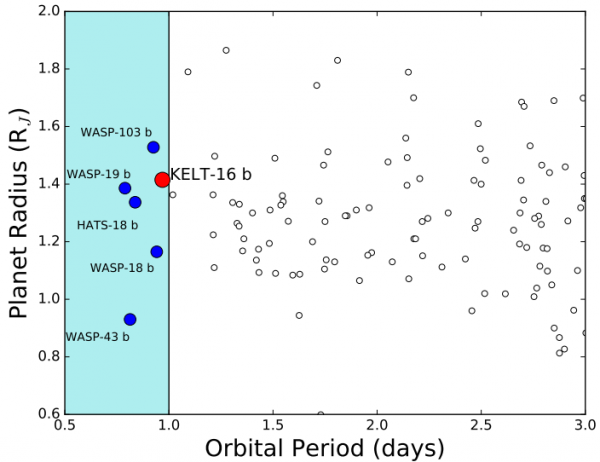March 21, 2017 report
Hot Jupiter KELT-16b offers unique opportunity for research

(Phys.org)—A large international team of researchers has found that a hot Jupiter called KELT-16b is likely to offer a unique opportunity for research for many years to come. In their paper published in The Astronomical Journal, the team describes known characteristics of the exoplanet and why they believe it offers an opportunity to learn more about several aspects of exoplanet characteristics and development.
Hot Jupiters are exoplanets that are roughly the size of Jupiter and that orbit their stars very closely. KELT-16b has been found to be within a radius of approximately 3 stellar radii above its host's surface, and orbits its star in just .97 days—only five other transiting exoplanets have been found that orbit their star in less than one day. It has also been found to be approximately 2.75 times the mass of Jupiter and has an equilibrium temperature of approximately 2453 K. Such a short period, the researchers note, will allow scientists to watch and record a transit every day, providing a unique opportunity to learn more about the planet and others like it. Researchers are able to learn more about an exoplanet's atmosphere when the exoplanet crosses its star—the starlight passing through can offer information not obtainable any other way. Also, the exoplanet's large size should provide a relatively easy-to-study target.
KELT-16b's host star, KELT-16, is approximately 1,300 light-years from Earth and about 1.2 times the mass of our sun—it also has a companion red dwarf. The researchers also believe that its gravitational pull has coaxed KELT-16b closer for the past billion years, and likely will pull the exoplanet apart in as few as 550,000 years.
The researchers believe study of the exoplanet by others working on different missions such as Hubble, Spitzer and the forthcoming James Webb Telescope will offer clues about such things as what happens at the boundary between day and night on such planets—such extreme temperature changes are likely to result in rain composed of vanadium and titanium oxide, for example. They also suggest that study of KELT-16b will help better understand how exoplanets evolve and move over time, including planet mortality.
More information: Thomas E. Oberst et al. KELT-16b: A Highly Irradiated, Ultra-short Period Hot Jupiter Nearing Tidal Disruption, The Astronomical Journal (2017). DOI: 10.3847/1538-3881/153/3/97 , On Arxiv: arxiv.org/abs/1608.00618
Abstract
We announce the discovery of KELT-16b, a highly irradiated, ultra-short period hot Jupiter transiting the relatively bright (V=11.7) star TYC 2688-1839-1. A global analysis of the system shows KELT-16 to be an F7V star with Teff=6236±54 K, logg⋆=4.253+0.031−0.036, [Fe/H] = -0.002+0.086−0.085, M⋆=1.211+0.043−0.046M⊙, and R⋆=1.360+0.064−0.053R⊙. The planet is a relatively high mass inflated gas giant with MP=2.75+0.16−0.15MJ, RP=1.415+0.084−0.067RJ, density ρP=1.20±0.18 g cm−3, surface gravity loggP=3.530+0.042−0.049, and Teq=2453+55−47 K. The best-fitting linear ephemeris is TC=2457247.24791±0.00019 BJDtdb and P=0.9689951±0.0000024 d. KELT-16b joins WASP-18b, -19b, -43b, -103b, and HATS-18b as the only giant transiting planets with P<1 day. Its ultra-short period and high irradiation make it a benchmark target for atmospheric studies by HST, Spitzer, and eventually JWST. For example, as a hotter, higher mass analog of WASP-43b, KELT-16b may feature an atmospheric temperature-pressure inversion and day-to-night temperature swing extreme enough for TiO to rain out at the terminator. KELT-16b could also join WASP-43b in extending tests of the observed mass-metallicity relation of the Solar System gas giants to higher masses. KELT-16b currently orbits at a mere ∼ 1.7 Roche radii from its host star, and could be tidally disrupted in as little as a few ×105 years (for a stellar tidal quality factor of Q′∗=105). Finally, the likely existence of a widely separated bound stellar companion in the KELT-16 system makes it possible that Kozai-Lidov oscillations played a role in driving KELT-16b inward to its current precarious orbit.
Journal information: Astronomical Journal , arXiv
© 2017 Phys.org




















